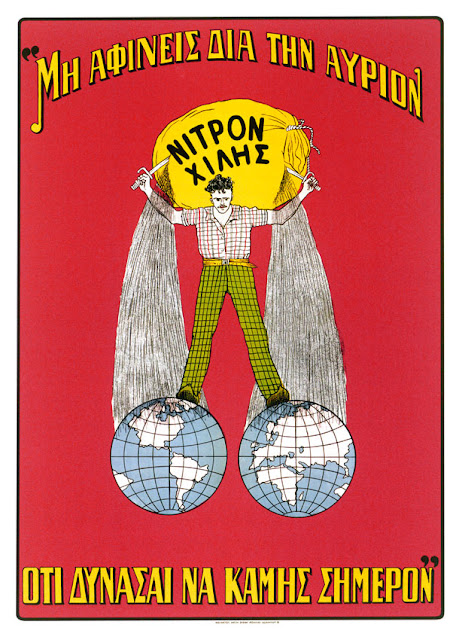As farmers recognized, manure was an important source of nutrients for their fields and bird manure, or gunao, was no exception. The word guano comes from the Quecha for fertilizer or manure, wanu. Bird guano was an even more potent source of soil nutrients than the manure European farmers were used to, with NPK up to 16-12-3. That's pretty high, cow manure has an NPK more like .75-.25-.5. In a world where everyone wanted nitrogen for their farms (and gun powder), bird guano was a valuable commodity.
So imagine finding literal mountains of the stuff. That's what you get when you have thousands upon thousands of birds excreting their meals of seafood onto islands which receive little rainfall. (If you want to see what that many birds looks like, check out this gallery or here). The Chinchas Islands off the coast of Peru were one such island, with mounds of precious precious guano layered 150 feet deep.
Above, you can see the Islas Chinchas and a whole lotta guano. The mountains of precious poop were excavated and loaded onto waiting ships. These pictures from the 1860s show that the Islas Chinchas were quite busy extracting the guano and shipping it out to Europe and the Americas. Fortunes were made (NYSE: GRA, Tyntesfield) and Peru started raking in the dough. So much dough that around the time these pictures were taken, the guano trade made up almost 60% of Peruvian government income.
More money more problems though. Spain had never recognized Peru's independence in 1821 and was looking to reassert some level of dominance in the 1860s. After some financial and diplomatic bullying on the part of Spain that Peru did not submit to, Spain occupied the Chincha Islands in 1864, recognizing their economic value. This was the opening act of the Chincha Islands War of 1864-1866 in which Chile, Ecuador, Boliva and Peru all allied against their former colonial master. Despite naval superiority, Spain had no invasion force to land and nowhere to resupply. The two year conflict ended when Spain pulled its forces out of the Pacific back to Europe by way of the Phillipines.
While the guano islands off the coast of South America was some fertilizer worth fighting over, the Chincha Islands War was a relatively small engagement. The fighting over the nitrogen found in the Atacama desert would be a different story.
The Atacama desert is the driest desert on earth. Scientists think the region has received no significant rainfall between 1570 and 1971 and that it has been extremely arid for around 200 million years. This lack of rainfall created a region rich in Sodium nitrate, known also as Chilean saltpeter. Potassium nitrate was also found in abundance. Miners started exploiting these reserves in the 1820s and soon the region would come to dominate the world market for nitrogen fertilizer for the next century. (More fortunes would be made here as well)
 Many Chilean miners worked in the saltpeter mines despite much of the Atacama desert being located on Peruvian and Bolivian territory. The Chilean owned Antofagasta Nitrate and Railway Company had an especially large stake in the region. Bolivia had agreed in 1874 not to increase taxes on Chilean interests for 25 years, but in 1878 the Bolivian government imposed higher taxes on the Antofagasta company which were retroactive to 1874. The company balked and so Bolivia moved to seize the company's assets. In response the Chilean army crossed the border and occupied the Bolivian port city of Antofagasta in the southern Atacama desert.
Many Chilean miners worked in the saltpeter mines despite much of the Atacama desert being located on Peruvian and Bolivian territory. The Chilean owned Antofagasta Nitrate and Railway Company had an especially large stake in the region. Bolivia had agreed in 1874 not to increase taxes on Chilean interests for 25 years, but in 1878 the Bolivian government imposed higher taxes on the Antofagasta company which were retroactive to 1874. The company balked and so Bolivia moved to seize the company's assets. In response the Chilean army crossed the border and occupied the Bolivian port city of Antofagasta in the southern Atacama desert.
Needless to say, at this point tensions were running high. 15 days after occupation of Antofagasta by Chilean forces, Bolivia declared war. Peru, bound by a secret alliance treaty with Bolivia, declared war on Chile little more than a month later. The War of the Pacific was a bloody conflict that would drag on for four years and ultimately deprive Bolivia of any access to the Pacific Ocean. The area outlined in black below is the territory that victorious Chile took from both Bolivia and Peru in the conflict
Most historians have argued that the desire to control the vast nitrate deposits of the Atacama (as well as some guano rich islands) was the underlying cause of the war. Bolivia to this day pressures the Chilean government to allow it a sovereign access point to the Pacific Ocean although with little effect. The saltpeter mines would be an important part of Chile's economy until the 1940s when synthetic nitrogen production made mining the Atacama for Sodium nitrate less profitable.
 |
| Check out these Chilean archives for more great nitrate fertilizer posters. |
It's easy to forget that all of this bloodshed was because people wanted to give their crops a little more nitrogen. The important role that soil nitrogen plays in crop yield means that nitrogen fertilizer was critically important to agriculture and humanity. Agriculture's dependence on nitrogen fertilizer continues to this day. Currently the world uses 100 teragrams, or 100,000,000,000 kilograms of nitrogen fertilizer every year. Without this annual addition of nitrogen to the worlds soils, our current agricultural system would collapse. This Greek man sums up the situation quite nicely as he dumps a sack of Chilean nitrate all over the world.
 |





No comments:
Post a Comment